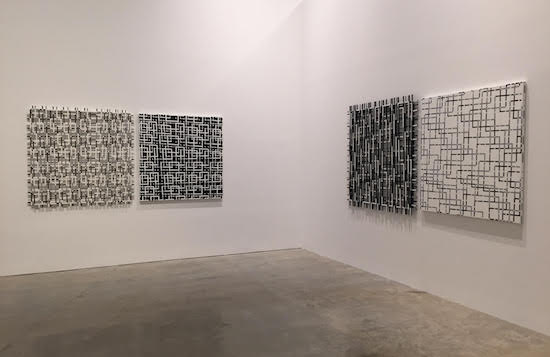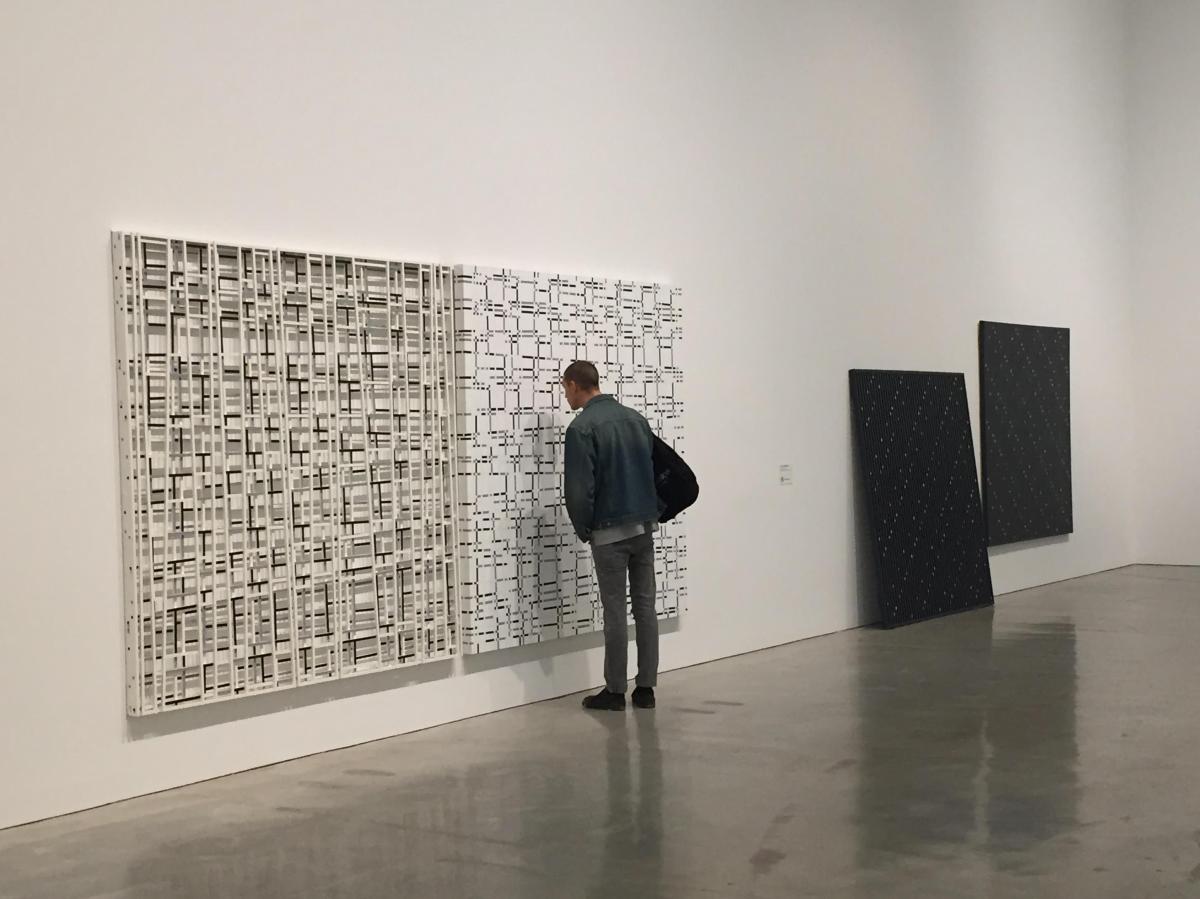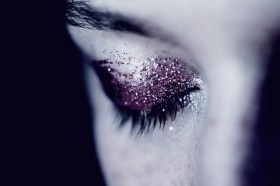Installation view Hilarie Mais at MCA; Photo ArtsHub
Walking into Hilarie Mais’ solo exhibition one can’t help but be seduced by its elegance. Filling the “white cube” gallery of the Museum of Contemporary Art Australia (MCA) it is both subtle and strong, eloquent and evocative, precise yet organic.
As Mais herself describes: ‘The work does not shout or demand, it reveals itself slowly … the outcome cannot be predetermined; it evolves, it can be a surprise.’
I suppose one of the great surprises is seeing this volume of work by the UK-born Mais. While she has been a very involved participant in the Sydney art world for decades, she has not been one of those artists who roll out the annual show.
In fact, this is Mais’ first major museum solo, despite making work since the early 1970s. The exhibition focuses on the last decade of her making – some 20 works – and yet the weight and background of her practice sits there in the wings. Her deep interest in the history of international abstraction from the US to the UK to Australia is inescapable.
Beauty in the hand
When we think of geometric abstraction, the mind immediately conjures hard edged fields of colour, rigorously chosen for their visual pop; or perhaps the optical energy of artists such as Bridget Riley, the quiet dedication of American painter Agnes Martin or the precise energy of British constructivists such as Kenneth Martin.
Mais fits within this broad field of abstraction but makes it her own. Constructing her assemblages from timber, their formal grid structure is softened by the organic material. There is an honesty to their making, and they seemingly breathe warmth and life into what otherwise might be conceived as linear coldness.
Perhaps that might be because many of the patterns Mais uses are drawn from biological forms and sequencing, such as the Fibonacci and the Golden Mean numbering systems. And yet, her work almost exclusively derives from the square and the grid, the spiral or circle – idioms that emerged in abstract art of the 1960s.
‘I have an interest in systems, in the search for order, the underlying logic, in identifying sequence and pattern. Also, the beauty in nature as governed by mathematical systems of growth and adaption,’ she explained.
This “life” is extended in her presentation of the work – her structures usually lean against a wall, or are suspended slightly away from it to cast shadows. That movement between two-dimensional and three-dimensional space and form is one of the most exciting aspects of Mais’ work, and to see it echoed across sculpture to painting in this exhibition is truly magical in the space.
As curator Victoria Lynne explained of Mais’ work: ‘We see the joins, the screws, the counting. In this way, Mais honours both the material and the process of making the work.’

Detail of reflection/feather, 2016, courtesy the artist and Kronenberg Wright Artists Projects, Sydney © the artist, photo ArtsHub
The exhibition has been curated by Blair French (MCA Director Curatorial and Digital) and Manya Sellers (MCA Assistant Curator).
Sellers said: ‘The presence of the artist is always evident in Mais’ work. Her grids are obviously hand-constructed and hand-painted, and their overall dimensions determined in relation to her own body, never larger than the outstretched reach of her arms. If “mistakes” occur they are left uncorrected, a celebration of the imperfect and the human.’
French added: ‘It is a privilege to work with Mais, whose practice is of great maturity, evidenced in part by the trust in simple materials, forms and processes, and by the way a particular form can be returned to over and over again, producing new meaning.’
The works
The didactic panel introducing the exhibition quotes Mais: ‘I make all my work from beginning to completion – I do not use fabrication or have assistants involved – so there is a deep engagement, and emotional investment with the work in physical terms and in time.’
The first diptych – or companion works – that the viewer is presented with are reflection / reach (2015) and reflection / feather (2016), which we are told are portraits of the artist and her late partner, artist, curator and critic William Wright AM.
Their scale is proportionate of our own scale, but also a doorway and a bed. Mais explains that the mathematical progression of the construction is based on the number 17, which is the birth-date for both Mais and Wright. It sets the tone for the show – light plays off dark; one grounded the other hung – the energy moving across the pair in deep conversation.

Installation view, Hilarie Mais, Museum of Contemporary Art, 2017. Featured left to right: reflection/reach, 2015, Collection of The University of Queensland, and reflection/feather, 2016; courtesy the artist and Kronenberg Wright Artists Projects, Sydney © the artist, photo ArtsHub
Moving into the gallery one’s eye is drawn to RES (2010) with its energetic red form. ‘Res’ literally means thing, object, fact, truth or reality, explains Victoria Lynne in her catalogue essay.
An exhibition highlight is the dual pairings, Mist II (2011) and Mist III (2012) – a sculpture placed left, a painting echoing it to the right. The depth is fantastic as the line moves between physical space and captures space on the canvas. As the eye darts back and forward we realise they are not replications – real and representation – but speak as one thing.

Installation view, Hilarie Mais, Museum of Contemporary Art, 2017. Featured left to right: Mist III 2012, and Mist II, 2011, National Gallery of Australia, Canberra; courtesy the artist and Kronenberg Wright Artists Projects, Sydney © the artist, photo ArtsHub
On the rear wall is a suite of works from her Tempus series (Latin word for time), made on an almost annual basis since 2006. It is explained: ‘Each work evolved from the same proposition of intersecting square/grid and circle/spiral geometric systems.’ Which does your eye gravitate to?
The works are constructed with a 7cm depth that is perforated, again playing with the work spatially.
Completing the exhibition is the multiple component work, Nomad (2006–12), produced as a colour spectrum – another system used within the history of abstract art – based upon waste plastics collected by Mais over a number of years.

Installation view, Hilarie Mais, Museum of Contemporary Art, 2017. Featured left to right: Mist III, 2012 and Nomad, 2006-12; courtesy the artist and Kronenberg Wright Artists Projects, Sydney © the artist, photo ArtsHub
Over the years I have seen casual outings of Mais’ work, but one really needs to experience this exhibition to fully understand the level of her inquiry.
Rating 4.5 out of 5
Hilarie Mais
Museum of Contemporary Art Australia (MCA)
23 August – 19 November
After its presentation at the MCA, the exhibition tours to TarraWarra Museum of Art, VIC, commencing 24 February – 29 April 2018, and the Drill Hall Gallery, ACT, from 7 June to 29 July 2018.





